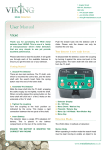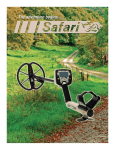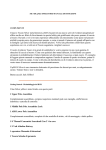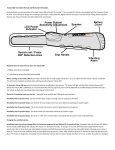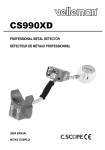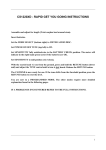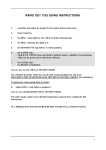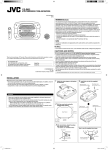Download Viking VK20 and VK30 - User Manual
Transcript
1 Angela Street Mill Hill, Blackburn BB2 4DJ t: +44 (0)1254 55887 f: +44 (0)1254 676901 Metal Detectors e: [email protected] User Manual VK20 & VK30 Thank you for purchasing a VK-Series detector from VIKING. This is one of a family of microprocessor driven metal detectors that are very simple to use yet provide excellent performance. The VK20 is a motion metal detector and the VK30 also provides non-motion operation, which assists with the accurate pinpointing of targets. Please take time to read this booklet. It will guide you through each of the available features to ensure you get the best out of your detector. The term 'motion' used above simply means the search head needs to be kept moving in order to detect metal items. This allows the microprocessor to analyse the received signals and discriminate against poor quality metals. When a suitable target is detected, an audible 'beep' is heard either from the loudspeaker or headphones (if connected). 3. Tighten the coupling Turn the coupling to the 'lock' position as indicated by the arrow. This makes a rigid connection between the two parts of the shaft. 4. Insert Battery The detector takes a single PP3 (alkaline) 9V battery. This is placed in the battery compartment on the back of the control box. ENSURE THE BATTERY IS INSERTED THE CORRECT WAY ROUND Push the drawer back into the detector until it clicks. Please note the drawer can only be inserted the one way. Getting Started 1 1. Unpack The Detector There are two main sections. The 'S' shaft, onto which is mounted the control box, armrest and detector stand, and the lower shaft with the search head. 2. Assemble The Detector Note the spring button clip protruding from near the top end of the lower shaft. Slide the lower shaft into the 'S' shaft, wrapping the cable snugly, but not tightly, round the shaft. When correctly aligned the spring button clip will click into 1 of the 3 holes in the 'S' shaft. 1 4 3 2 VK20 Display Panel 1. 2. 3. 4. Off / On - Sensitivity Control Discrimination Control Detector Display Inland / Beach Switch www.metaldetectors.co.uk 1 Angela Street Mill Hill, Blackburn BB2 4DJ t: +44 (0)1254 55887 f: +44 (0)1254 676901 Metal Detectors e: [email protected] When this control is adjusted, the display unit indicates the current setting. 3 Sensitivity Adjust 4 1 5 2 VK30 Display Panel 1. 2. 3. 4. 5. Off / On - Sensitivity Control All Metal / Discrimination Control Detector Display Inland / Beach Switch Target ID Pinpoint / Retune Pushbutton 1. Off / On - Sensitivity Control This control has two functions. When turned fully anticlockwise the detector is switched off. Turning the control clockwise will initially turn the machine on. Turning the control further clockwise will increase the sensitivity setting of the detector. Maximum sensitivity is achieved when the control is turned fully clockwise. The ability of the detector to locate small or deep objects will increase with the sensitivity setting. In some environmental conditions the detector may produce false beeps which do not indicate a target. In this case it is recommended that the sensitivity setting is reduced until the problem is resolved. 2. Discrimination Control On the VK30 only: this control has two functions. When turned fully anticlockwise it will click and switch the detector into All-Metal mode. Turning the control slightly clockwise will switch the detector into Motion mode and from this point the control will work exactly as on the VK20. This control is used to discriminate against unwanted metal targets. When turned fully anticlockwise, all metal targets will be found. The further the control is turned clockwise the more discriminating the detector will be. When turned fully clockwise only the most conductive metals (Silver and Copper) will be found. All other targets will be ignored. For general detector use it is not recommended to search with the discrimination control set to full as you may miss the most valuable targets. Items such as gold rings are not as conductive as a piece of copper and will be missed if the discrimination control is set too high. When this control is adjusted, the display unit indicates the current setting. The number displayed relates to the minimum target ID number that will give an audio signal when detected Audio Discrimination Adjust 2 www.metaldetectors.co.uk 1 Angela Street Mill Hill, Blackburn BB2 4DJ t: +44 (0)1254 55887 f: +44 (0)1254 676901 Metal Detectors 3. Beach / Inland Switch This switch is used for detecting on the beach. Pressing the button once will switch the detector into beach mode. Pressing it again will switch back into inland mode. The display will show 'B' when beach mode is selected. When using this mode the detector will not detect iron objects, but will still provide an audio signal and target ID for non-ferrous metals. Note that the detector will always reset to inland mode when the power is switched off Detection in Beach Mode 4. Target ID This part of the display provides an indication of the identity of each target. When the search head is swept past a target a number, between 0 and 95, is shown on the display and the bar fills up to a point. If only one or two blocks appear and the number that appears is low then the object is likely to be iron. If seven or eight blocks are shown and the number is high then the object is likely to be of high conductivity. Some Typical Targets: e: [email protected] 5. All Metal Mode (VK30 only) Turning the discrimination control fully anticlockwise switches the detector into All Metal mode. This mode allows more accurate pinpointing of the target as the search head does not need to be kept moving to detect. 6. Pinpoint / Retune Button (VK30 only) When in Motion mode, pressing and holding this button switches the detector into All Metal mode. When detecting in All Metal mode, holding this button switches the detector to Motion mode and also retunes the threshold tone. When the detector is in Non-Motion mode, whether chosen by the discrimination control or the pushbutton, the display shows a 'P'. The display gives the target ID of the object as in motion mode. Please note that although there is increased sensitivity when using non-motion mode, the display is not capable of correct ID for small signals that would not be detected in Motion mode. Non-Motion Detection 7. Battery Check The detector continually monitors the condition of the battery. As the battery power begins to fade, the blocks used to indicate target ID or control position reduce in size. When the blocks show up as a thin line the battery should be replaced. Small Iron (Nail) 3 Modern 5p Battery Fading Victorian (Silver) Shilling Replace Battery www.metaldetectors.co.uk 1 Angela Street Mill Hill, Blackburn BB2 4DJ t: +44 (0)1254 55887 f: +44 (0)1254 676901 Metal Detectors 8. Headphone Socket This is on the underside of the control box and will accept a standard pair of headphones with a ¼" stereo jack plug. The loudspeaker will be disabled when a plug is inserted into the headphone socket. Headphones are particularly recommended for searching in Non-Motion mode. 9. Adjustable Armrest The armrest is fixed with a screw. Loosening this with a screwdriver allows the position of the armrest to be moved back and forwards. Push the armrest to the position that provides you with the most comfort for detecting and tighten the screw. Using Your Detector First, switch your detector on by turning the sensitivity control clockwise. Continue turning the control until it is at the sensitivity level you require. Secondly set the desired level of discrimination. Remember that with the discrimination full on your detector will ignore many valuable targets, for example gold rings and much modern coinage. When starting out it is recommended that a medium setting of about 40-50 should be used. This will reject trash metals such as iron yet still detect all coinage. The detector will still detect ring pull-tabs and silver foil. With experience the setting at which most rubbish is ignored and desired objects are still found will become apparent. This can only be determined by trial and error and depends on the preference of the individual detectorist. To detect, hold the detector by the handgrip with your arm in the rest. Lower the search head to the ground ensuring that it is flat to the ground. If you feel the length of the shaft or the position of the armrest are wrong adjust them now. 4 e: [email protected] Keeping the head close and parallel to the ground, sweep it back and forth in an arc in front of you. The speed at which you sweep is not critical but remember that the machine is more likely to miss targets if you go too fast. Walk slowly forward as you sweep, allowing the area searched each time to overlap with that searched by the previous sweep to avoid missing targets. The detector will emit a beep when an object is detected. The display will also give a target ID number as described earlier. Repeated sweeps are recommended to obtain a more accurate reading. The object can then be pinpointed either by pressing the Pinpoint button which switches the detector to All Metal mode (VK30 only) or by repeatedly sweeping over it and noting where the head is when the sound occurs. More accurate pinpointing can be achieved by sweeping at 90 from the original direction. The intersection of the sweeps that produce a beep is where the object lies. The target ID system is not infallible. The signals received from round steel objects, for example a washer or recent 2p piece, can confuse the detector. If repeated sweeps over a target give a wide range of numbers and the number of blocks shown on the display varies greatly this is the detectors way of telling the user that one of these 'problem' objects has been found. The choice to dig or not is up to the user. Remember that the display only acts as a guide. Beach Detection When detecting on beaches the detector will produce more false signals especially as you near the water's edge. To overcome this, switch www.metaldetectors.co.uk 1 Angela Street Mill Hill, Blackburn BB2 4DJ t: +44 (0)1254 55887 f: +44 (0)1254 676901 Metal Detectors e: [email protected] the detector into Beach mode. In Beach mode the detector will ignore Iron. All Metal Mode (VK30 only) The All Metal mode works by producing a faint threshold tone. This will only be heard when headphones are used. As the search head moves over a metal object the volume of this tone increases and is at a maximum when the centre of the head is directly above the object. This feature can be used in two ways. The detector can be used in motion mode as previously described. When an object is found the push button can be held in to pinpoint an object. If the threshold tone drifts, release and repress the button to retune the detector. An alternative method of use is to search in All Metal mode as selected by the discrimination control. The push button can be used to retune the detector if drift has occurred by pressing and releasing it. Alternatively, holding in the button will switch the detector to motion mode for accurate discrimination. Problem Possible Cause Remedy No sound from speaker Battery Check battery is good & inserted correctly Headphones connected Remove headphones Sensitivity too low Increase sensitivity Discrimination too high Decrease discrimination Cable detection Wrap cable snugly round shaft Noisy conditions Reduce sensitivity Heavily mineralised ground conditions Increase discrimination Reduce sensitivity Detector not tuned to threshold (VK-30 Only) Press retune button / Switch to motion mode Unit does not detect targets False Signals Continuous tone from speaker If you are experiencing any problems not covered by the above see page 6 for details of our warranty / repair service. 5 www.metaldetectors.co.uk 1 Angela Street Mill Hill, Blackburn BB2 4DJ t: +44 (0)1254 55887 f: +44 (0)1254 676901 Metal Detectors e: [email protected] Caring for Your Detector Warranty Service In order to keep your machine in good condition, please take the following precautions: Return of the enclosed guarantee card entitles the original purchaser to a full 2-year guarantee from the original purchase date. This covers parts and labour, excluding batteries. This does not, however, cover postage of the unit to or from our factory. This must be paid by the owner of the detector. • When using in bad weather, protect the electronics in the control box by wrapping in a waterproof bag. • Clean your detector regularly and ensure the shaft is free from dirt, especially sand. Use a damp cloth with mild detergent, but make sure no water gets into the control box. If the detector is stored for long periods remove the batteries. If they leak or corrode they could cause serious damage to the detector. In the unlikely event that you do need to return the detector to us, please pack it securely along with a letter explaining the problem and a cheque for £6.00 to cover return carriage and insurance to: Viking Metal Detectors 1 Angela Street Mill Hill Blackburn Lancs. BB2 4DJ Please make cheques payable to Viking Metal Detectors. If you are unsure about the fault please give us a call on (01254) 55887 and we will be happy to advise you. 6 www.metaldetectors.co.uk 1 Angela Street Mill Hill, Blackburn BB2 4DJ t: +44 (0)1254 55887 f: +44 (0)1254 676901 Metal Detectors e: [email protected] Code of Conduct for Responsible Detector Users 1. Do not trespass. Ask permission before venturing onto any private land. 2. Respect the country code. Do not leave gates open when crossing fields. Do not damage crops or frighten animals. 3. Do not leave a mess. It is perfectly simple to extract a coin, or other small object, buried a few inches under the ground without digging a large hole. Use a sharpened trowel or knife to cut a neat flap (Do not remove the plug of earth completely from the ground), extract the object, replace the soil and grass carefully. Even you will have difficulty in finding the spot again. 4. Help to keep Britain tidy - and help yourself. Bottle tops, silver paper and tin cans are the last thing you should throw down again. It is possible you will find yourself digging them up again in the future. Do yourself and the community a favour by taking the junk you find to the nearest litter bin. 7 5. If you discover any live ammunition or other lethal objects such as an unexploded bomb or mine, do not touch it. Mark the site carefully and report the find to the local police and landowner. 6. Report all unusual, historical finds to the landowner. 7. Familiarise yourself with the law relating to archaeological sites. Remember it is illegal for anyone to use metal detectors on a scheduled ancient monument unless permission has been obtained from the historic buildings and ancient monuments commission. Also acquaint yourself with the practice of treasure trove. 8. Remember that when you are out with your metal detector you are an ambassador for your hobby. Do nothing that may give it a bad name. 9. Never miss an opportunity to show and explain your detector to anyone who asks about it. Be friendly. You could pick up some useful clues to the whereabouts of another site. If you meet another detector user, introduce yourself. You may learn much about the hobby from each other. www.metaldetectors.co.uk







